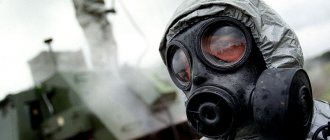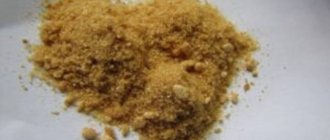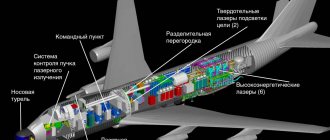Biological or bacteriological weapons are a type of weapon of mass destruction (WMD) that use various pathogens to destroy the enemy. The main purpose of its use is the mass destruction of enemy personnel; to achieve this, epidemics of dangerous diseases are provoked among his troops and civilians.
The term “bacteriological weapon” is not entirely correct, since not only bacteria are used to defeat the enemy, but also viruses and other microorganisms, as well as the toxic products of their vital activity. In addition, biological weapons include means of delivering infectious agents to the place of their use.
Sometimes entomological weapons are identified as a separate species, which use insects to attack the enemy.
Modern war is a whole complex of actions aimed at destroying the enemy’s economy. Biological weapons fit perfectly into his concept. After all, it is possible to infect not only enemy soldiers or its civilian population, but also destroy agricultural crops.
Biological weapons are the oldest type of weapon of mass destruction; people tried to use them in ancient times. This was not always effective, but sometimes led to impressive results.
Currently, biological weapons are outlawed: a number of conventions have been adopted prohibiting their development, storage and use. However, despite all international conventions, information regularly appears in the press about new developments of these prohibited weapons.
Many experts believe that bacteriological weapons are in some ways even more dangerous than nuclear weapons. Its properties and features are such that they may well lead to the complete destruction of the human race on the planet. Despite modern advances in the field of medicine and biology, it is not yet possible to talk about the victory of humanity over diseases. We cannot yet cope with HIV infection and hepatitis, and even a common flu leads to regular epidemics. The action of biological weapons is not selective. A virus or pathogenic bacterium does not distinguish between friend and foe, and once released, they destroy all living things in their path.
History of biological weapons
Humanity has repeatedly faced devastating epidemics and fought a huge number of wars. Often these two disasters went hand in hand. Therefore, it is not surprising that many military leaders came up with ideas about using infections as weapons.
It should be noted that high morbidity and mortality rates were common in armies of the past. Huge human concentrations, vague ideas about sanitation and hygiene, poor nutrition - all this created excellent conditions for the development of infectious diseases in the troops. Very often, many more soldiers died from illnesses than from the actions of the enemy army.
Therefore, the first attempts to use infections to defeat enemy troops were made several thousand years ago. The Hittites, for example, simply sent people suffering from tularemia to the enemy camp. In the Middle Ages, they came up with new ways to deliver biological weapons: the corpses of people and animals who died from some fatal illness were thrown into besieged cities using catapults.
The most terrible result of the use of biological weapons in antiquity is the bubonic plague epidemic in Europe, which broke out in the 14th century. During the siege of the city of Kafa (modern Feodosia), the Tatar Khan Janibek threw the corpses of people who died from the plague behind the walls. An epidemic began in the city. Some of the townspeople escaped from her on a ship to Venice, and they ended up bringing the infection there.
Soon the plague literally wiped out Europe. Some countries lost up to half of their population, and the epidemic's victims numbered in the millions.
In the 18th century, European colonialists supplied North American Indians with blankets and tents that had previously been used by smallpox patients. Historians still debate whether this was done intentionally. Be that as it may, the resulting epidemic practically destroyed many native tribes.
Scientific progress has given humanity not only vaccinations and antibiotics, but also the ability to use the most deadly pathogens as weapons.
The process of rapid development of biological weapons began relatively recently - around the end of the 19th century. The Germans tried, to no avail, to cause an anthrax epidemic in enemy forces during World War I. During World War II, Japan created a special secret unit - Detachment 731, which carried out work in the field of biological weapons, including experiments on prisoners of war.
During the war, the Japanese infected the Chinese population with bubonic plague, which killed 400 thousand Chinese. The Germans actively and quite successfully spread malaria in the territory of modern Italy, and about 100 thousand Allied soldiers died from it.
After the end of World War II, these weapons of mass destruction were no longer used, or at least no signs of their large-scale use were recorded. There is information that the Americans used biological weapons during the Korean War, but this fact could not be confirmed.
In 1979, an anthrax epidemic broke out on the territory of the USSR in Sverdlovsk. It was officially announced that the cause of the outbreak was the consumption of meat from infected animals. Modern researchers have no doubt that the real reason for the defeat of the population by this dangerous infection was an accident at a secret Soviet laboratory where biological weapons were being developed. In a short period, 79 cases of infection were recorded, 68 of which were fatal. This is a clear example of the effectiveness of biological weapons: as a result of accidental infection, the mortality rate was 86%.
Lower forms
These include various insects. They can pose a greater danger to humans than a lack of food or water. The threat is manifested in their ability to transmit infectious disease through their bite. This group of biological hazards is characterized by the following characteristics:
- The ability to survive and reproduce in certain conditions. These processes occur especially well in sunny places at positive temperatures. This suggests that in a certain area at a specific period of time a person will be surrounded by biological hazards in limited quantities.
- Often the pathogen passes through one or a large number of specific carriers. However, as a rule, this occurs with the help of an organism that feeds the parasites. If it is absent, then the causative agent of the disease will also not be present. In such cases, a person becomes a specific organism (for example, with malaria).
Features of biological weapons
Advantages:
- High efficiency of application;
- The difficulty of timely detection by the enemy of the use of biological weapons;
- The presence of a hidden (incubation) period of infection makes the fact of the use of this weapon of mass destruction even less noticeable;
- A wide variety of biological agents that can be used to defeat the enemy;
- Many types of biological weapons are capable of epidemic spread, that is, defeating an enemy essentially becomes a self-sustaining process;
- The flexibility of this weapon of mass destruction: there are diseases that temporarily make a person incapacitated, while other ailments lead to death;
- Microorganisms are capable of penetrating into any premises; engineering structures and military equipment also do not guarantee protection against infection;
- The ability of biological weapons to infect people, animals, and crops. Moreover, this ability is very selective: some pathogens cause human diseases, others infect only animals;
- Biological weapons have a strong psychological impact on the population, panic and fear instantly spread.
It should also be noted that biological weapons are very cheap; creating them is not difficult even for a state with a low level of technical development.
However, this type of WMD also has a significant drawback that limits the use of biological weapons: it is extremely indiscriminate.
Once exposed to a pathogenic anthrax virus or bacillus, you cannot guarantee that the infection will not devastate your country as well. Science is not yet able to provide guaranteed protection against microorganisms. Moreover: even a pre-created antidote may be ineffective, because viruses and bacteria are constantly mutating.
That is why biological weapons have practically not been used in recent history. It is likely that this trend will continue in the future.
Cyborg bugs
Although entomological and other biological weapons are strictly prohibited today, they have learned to use insects not only for the purpose of harming other living organisms, but also for reconnaissance purposes. So, a microcontroller, battery and electrode are implanted into the insect pupa. When she transforms into a beetle, she can control it remotely, setting a route and ordering it to stop when required. An ideal scout for military service! Research is currently being carried out only in closed laboratories, but it is unlikely that the hour will be far off when we will be monitored by cyborg insects connected to a Wi-Fi network.
Classification of biological weapons
The main difference between different types of biological weapons is the pathogen used to defeat the enemy. It is he who determines the basic properties and characteristics of weapons of mass destruction. Causative agents of various diseases can be used: plague, smallpox, anthrax, Ebola fever, cholera, tularemia, tropical fever, as well as botulism toxins.
Various means and methods can be used to spread infections:
- artillery shells and mines;
- special containers (bags, packages or boxes) scattered from the air;
- aircraft bombs;
- devices that disperse aerosols containing infectious agents from the air;
- contaminated household items (clothing, shoes, food).
Separately, entomological weapons should be highlighted. This is a type of biological weapon that uses insects to attack the enemy. At various times, bees, scorpions, fleas, Colorado potato beetles and mosquitoes were used for these purposes. The most promising are mosquitoes, fleas and some types of flies. All these insects can carry various diseases of humans and animals. At various times, there were programs to breed agricultural pests in order to damage the enemy’s economy.
Practical recommendations
When working with blood and other biological fluids, safety precautions must be observed. It is necessary to ensure proper handling and storage of instruments, especially sharp objects, and maintain personal hygiene. Smoking, eating and drinking are prohibited in the laboratory. Products must not be stored in refrigerators intended for clinical materials. Disinfection of work surfaces should be carried out daily and if necessary (in case of contact with biomaterial). Employees are provided with personal protective equipment (gloves of appropriate size, face masks or shields, goggles).
Protection against weapons of mass destruction
All methods of protection against biological weapons can be divided into two large groups:
- preventive;
- emergency.
Preventive control methods include vaccination of military personnel, civilians, and farm animals. The second direction of prevention is the creation of a whole set of mechanisms that make it possible to detect infection as quickly as possible.
Emergency methods of protection against biological threats include various methods of treating diseases, preventive measures in emergency cases, isolating the source of infection, and disinfecting the area.
During the Cold War, several exercises were conducted to eliminate the consequences of the use of biological weapons. Other modeling methods have also been used. As a result, it was concluded that a state with normally developed medicine is able to cope with any known type of such weapon of mass destruction.
However, there is one problem: modern work on creating new types of combat microorganisms is based on the methods of biotechnology and genetic engineering. That is, developers are creating new strains of viruses and bacteria with unprecedented properties. If such a pathogen breaks free, it could lead to the start of a global epidemic (pandemic).
Recently, rumors about so-called genetic weapons have not subsided. Usually it refers to genetically modified pathogenic microorganisms that are capable of selectively infecting people of a certain nationality, race or gender. However, most scientists are quite skeptical about the idea of such a weapon, although experiments in this direction have definitely been carried out.
Bee menace
First, let's talk about one of the most harmless ways to use insects in military conflicts - the use of "sniffing" bees. About ten years ago, scientists finally decided to use the phenomenal sense of smell of bees not only to obtain honey, but also to detect explosives, and trained a group of bees to recognize TNT. Research has not yet been completed, but perhaps in the near future bees will begin to perform the duties of sappers everywhere.
Bees were often used as biological weapons in wars involving the Romans. /For example, they came up with the idea of catapulting entire beehives into the enemy camp. Enraged and blinded by rage, the bees, whose home had been destroyed, rushed at all the soldiers they could attack in the immediate area. Such entomological weapons have become an effective technique in more than one battle. It is also interesting that the Dacians, attacked by bees, quickly realized what was what, and repaid the Romans in the same coin, throwing new hives back.
There are also records that bee “bombs” were used by King Richard the Lionheart during the Third Crusade in the 12th century. And in the 18th century, during the Battle of Alba Grajek (modern Belgrade), city residents managed to fight off Turkish soldiers by building barricades from beehives. And that's not all: in the war between Italy and Ethiopia, in the first half of the 20th century, Ethiopian partisans successfully eliminated enemy tanks by throwing beehives directly into the hatch.
Representatives of one of the Nigerian tribes, the Tiv, also actively used biological weapons in the form of bees. They caught bees and placed them in special wooden tubes, from which it was then convenient to blow them out in close combat directly at the enemy.
And the inhabitants of English and Scottish fortresses acted even smarter during the Middle Ages. They prepared for war in advance, specially attracting bees into their walls so that they would set up an abode for themselves right in the fortress. In peacetime, insects brought honey as usual, and when the fortress was attacked, they rushed to defend their home.
Meliodia.
Meliodia is an infectious disease of humans and rodents, similar to glanders. The causative agent, due to its similarity with glanders, is called the false glanders bacillus. The microbe is a thin rod, does not form spores, has mobility due to the presence of a bundle of flagella at one end, is resistant to drying, and at a temperature of 26-28 degrees remains viable in soil for up to a month, in water for more than 40 days. Sensitive to disinfectants and high temperatures - under their influence it dies in a few minutes.
Meliodia is a little-known disease found in Southeast Asian countries. The carriers are small rodents in which the disease occurs in a chronic form. The pus, feces and urine of sick animals contain many pathogens of meliodia. Human infection occurs through consumption of food and water contaminated with secretions of sick rodents. As with glanders, the disease can enter the body through damaged skin and mucous membranes of the eyes, nose, etc.
With artificial propagation, i.e. If this disease is used as a component of a biological weapon, meliodia microbes can be dispersed into the air or used to contaminate food and food products.
The possibility of meliodia infecting humans with meliodia cannot be ruled out, although no such facts have been noted. Patients are subject to isolation due to the similarity of symptoms of meliodia with other diseases.
Manifestations of the disease in humans are varied and can occur in 3 stages. The disease begins within a few days.
Acute meliodiasis occurs very violently, resembling cholera or typhoid fever. The disease begins with chills, vomiting and diarrhea, the temperature rises sharply to 40-41 degrees. The patient complains of a severe headache and soon loses consciousness. Shortness of breath and cough with bloody sputum develop. Sometimes the temperature rises gradually and remains at 40-40.5 degrees with small drops, headaches and severe pain in the nerves and parts of the stomach appear. The patient's condition worsens and he loses consciousness. Inflammatory foci develop in the lungs, vomiting and diarrhea are observed, which is often replaced by constipation. In the second week of the disease, purulent foci appear under the skin, in the muscles and bones. Death occurs on the 10-15th day from the onset of the disease.
Subacute meliodiasis is a less severe stage of the disease that lasts longer. The temperature remains at 40 degrees, and the development of ulcers in various organs of the human body is noted. If left untreated, the disease ends in death within 3-4 weeks.
Chronic meliodiasis is rare. The main signs of this form of the disease are purulent lesions of organs and tissues. The temperature rises and falls. The disease lasts from several months to several years and leads to exhaustion and death.
An effective vaccine for this disease has not been created. Positive results in the treatment of meliodia were obtained relatively recently using chlortetracycline, chloramphenicol, and sulfadiazine.
The application of this disease can be different: the use of microbial cultures in aerial bombs, projectiles, air-draining devices, and sprayers gives different results. Meliodia can also be used by sabotage units to infect air supply systems, water sources, and food storage facilities. Protection against this disease if it is used as a biological weapon can be provided by wearing protective clothing, equipment, a gas mask in the contaminated area, and mandatory disinfection of food and water. To prevent the spread of this disease, weapons and equipment that have been in infected zones should be disinfested, and the contaminated area should be deratized.
Second category
Work in the laboratory is carried out in accordance with safety regulations. The premises and equipment are suitable for activities involving a wide range of known microorganisms that are considered to be of moderate hazard and cause moderate illness. There are a number of requirements for the laboratory:
Personnel must undergo special training in working with pathogens under the supervision of experienced staff. A biohazard symbol must be present indicating restricted access to the laboratory. It is recommended to be careful when using sharp objects. Special precautions are required for operations in which there is a possibility of splash or aerosol cloud formation. The use of a physical protective barrier is recommended
Work should be carried out in class 1 and 2 safety boxes.











